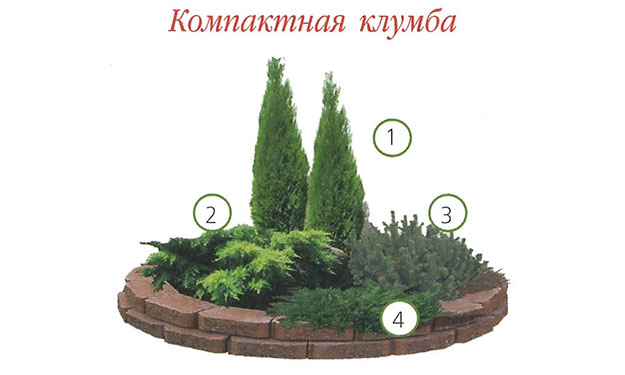Main coniferous plants in the compositions of the garden are not tall conifers (pines, spruces, firs), but their compact and undersized forms. Coniferous compositions are perfectly combined with shrubs (rhododendrons, erics, heathers, barberries, spireas, evergreen boxwoods), herbaceous perennials (hostas, ferns, cereals). When creating a flower bed, it is necessary to plant ground cover plants in the foreground (creeping tenacious, styloid phlox, sedum, thyme, bryozoan, etc.). Spring bright colors will bring bulbous (crocuses, muscari, undersized tulips). It is very important to think over the layout of plants. Groups must be created according to the principle of contrast of form and color. For example, columnar forms are well emphasized by spherical, dense-bush and creeping forms, with different types, textures and colors of needles. The needle needles of junipers, firs and pines go well with the scaly needles of thuja. When selecting plants, their maximum height should be clarified. Coniferous compositions can only be composed of slow-growing and dwarf varietal forms.
12 varieties of coniferous flower beds
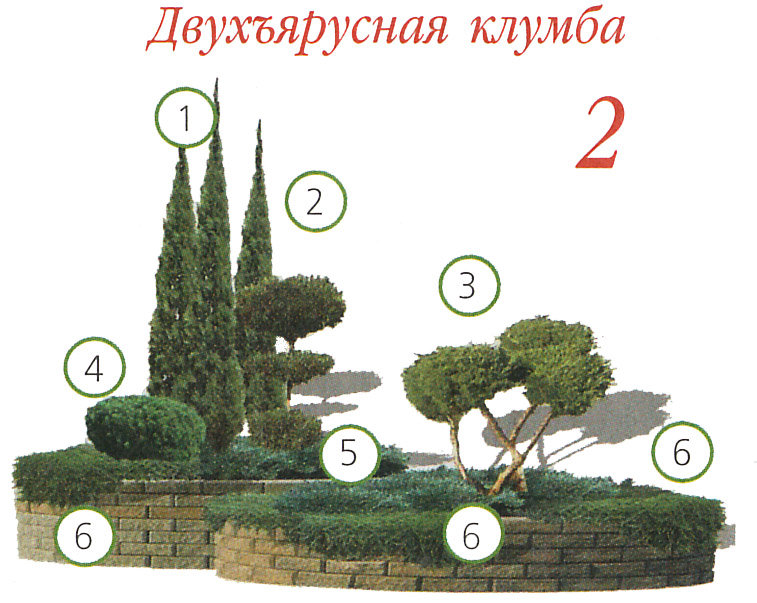
2. Juniper rock "Skyrocket" molded
3. Juniper scaly "Meyeri" molded
4. Pine mountain "Mops"
5. Juniper horizontal "Blue Chip"
6. Lying juniper "Nana"
 1. Dense-flowered pine "Umbraculiefera"
1. Dense-flowered pine "Umbraculiefera"
2. Pine mountain "Mops"
3. Juniper horizontal "Green Carpet"
4. Ground cover perennials "Bryozoan or stonecrop"
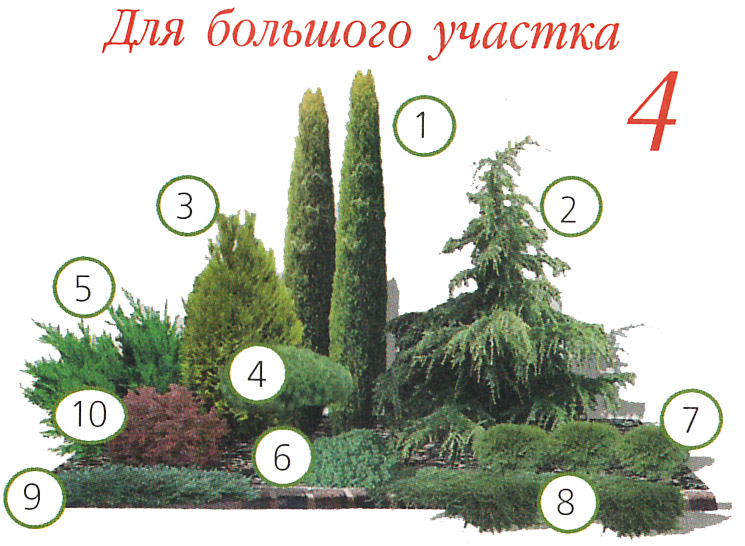 1. Common juniper "Suecica"
1. Common juniper "Suecica"
2. Common juniper "Horstman"
3. Thuja western "Rheingold"
4. Mountain pine "Mops" on trunk
5. Juniper "Mint Julep"
6. Juniper scaly "Blue Star"
7. Thuja western "Danica"
8. Horizontal juniper "Wiltonii"
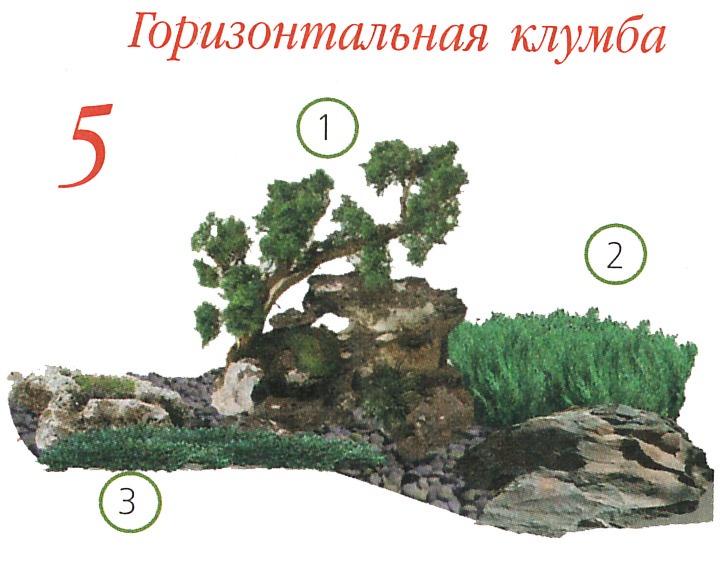 1. Virginian juniper "Grey Owl" molded
1. Virginian juniper "Grey Owl" molded
2. Juniper horizontal "Andorra Compact"
3. Juniper horizontal "Prince of Wales"
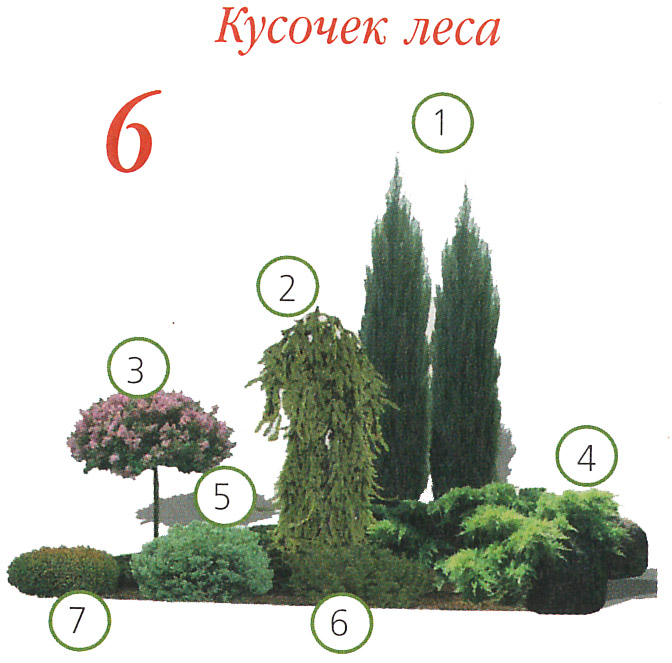 1. Juniper rock "Skyrocket"
1. Juniper rock "Skyrocket"
2. Norway spruce "Inversa"
3. Lilac "Meyeri" on the trunk
5. Canadian spruce "Echiniformis"
6. Pine mountain "Mops"
7. Thunberg barberry "Bonanza Gold"
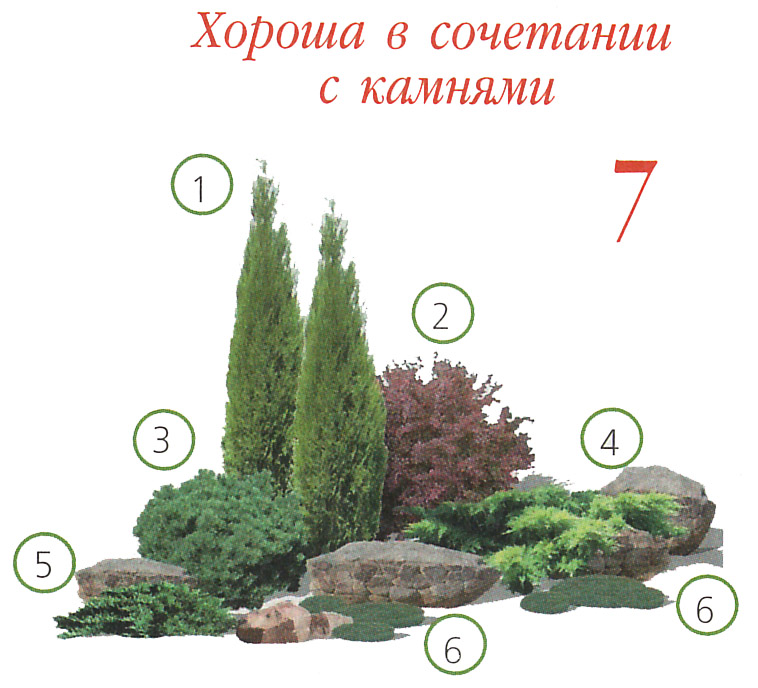 1. Thuja western "Holmstrup"
1. Thuja western "Holmstrup"
3. Pine mountain "Mops"
4. Juniper average "Old Gold"
5. Juniper Cossack "Tamariscifolia"
6. Ground cover perennials "Bryozoan or stonecrop"
 1. Thuja western "Smaragd"
1. Thuja western "Smaragd"
2. Japanese larch "Stiff Weeper"
3. Barberry thunberg "Red Chief"
4. Thuja orientalis "Aurea Nana"
5. Pine mountain "Mops"
6. Juniper average "Old Gold"
7. Juniper Cossack "Blaue Donau"
8. Juniper horizontal "Prince of Wales"
9. Juniper horizontal "Blue Chip"
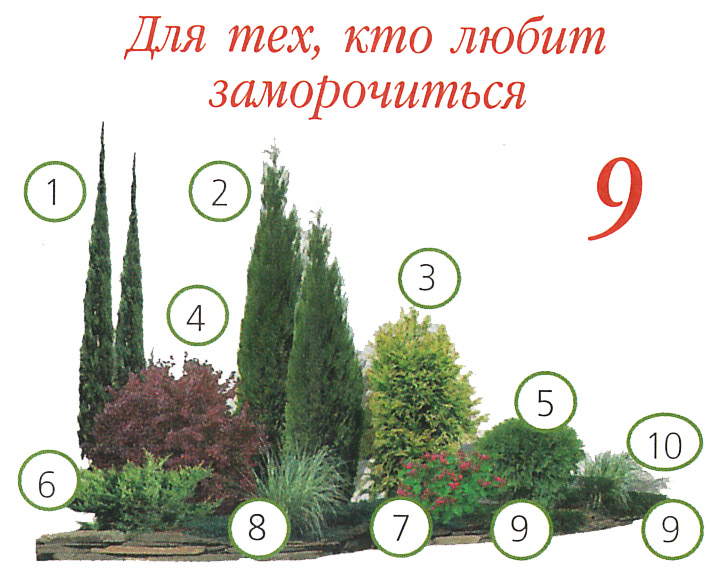 1. Rocky juniper "Blue Arrow"
1. Rocky juniper "Blue Arrow"
2. Thuja western "Holmstrup"
3. Thuja western "Europe Gold"
4. Barberry thunberg "Red Chief"
5. Thuja western "Globosa"
6. Juniper average "Gold Star"
7. Japanese spirea "Little Princess"
8. Juniper horizontal "Blue Chip"
9. Juniper horizontal "Prince of Wales"
10. Morrow's sedge (or similar grasses)
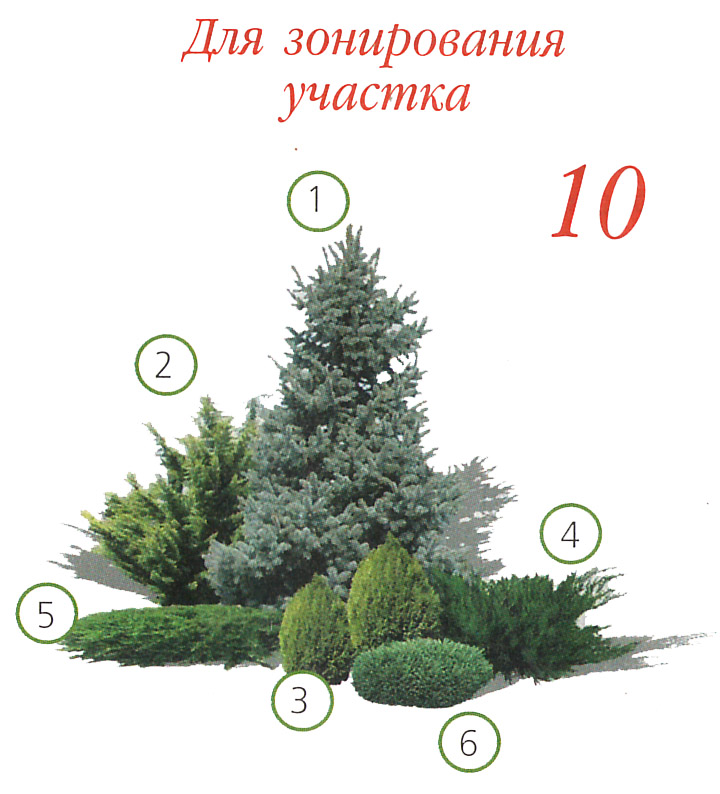
1. Prickly spruce "Hoopsii"
2. Juniper Chinese "Blaauw"
3. Thuja orientalis "Aurea Nana"
4. Juniperus average "Pfitzeriana"
5. Coastal juniper "Schlager"
6. Norway spruce "Little Gem"
![]() 1. Canadian spruce "Conica"
1. Canadian spruce "Conica"
2. Juniper horizontal "Blue Chip"
3. Lying juniper "Nana"
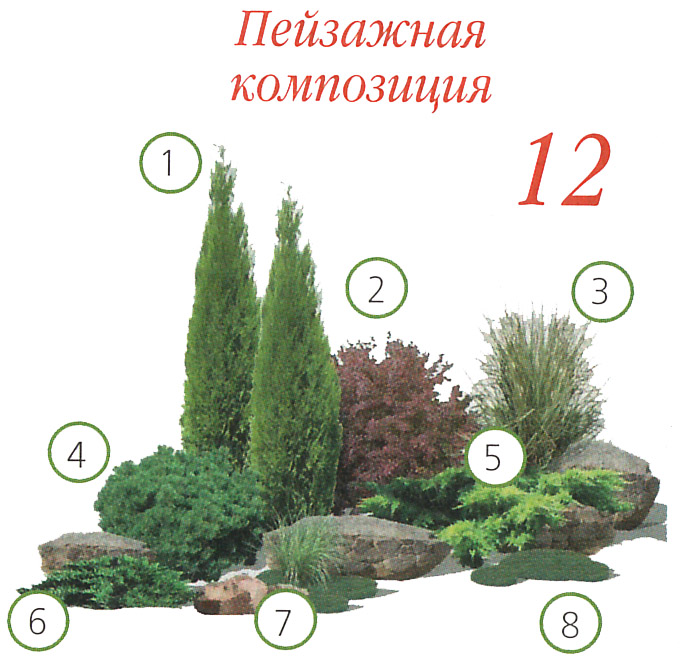 1. Thuja western "Holmstrup"
1. Thuja western "Holmstrup"
2. Barberry thunberg "Red Chief"
3. Miscanthus Chinese "Zebrinus"
4. Pine mountain "Mops"
5. Juniper average "Old Gold"
6. Juniper Cossack "Tamariscifolia"
7. Morrow's sedge (or similar grasses)
8. Ground cover perennials "Bryozoan or stonecrop"
In nature, adult conifers cast a large shadow. Therefore, for ornamental gardening, undersized varieties were specially bred, only 3-4 meters high. They fit well into the landscape of the site. The background is a lawn and an alpine slide. If the size of your site allows you to plant large-sized trees, remember: cedar and pine should not be planted next to firs and Christmas trees. Larch generally does not like either one or the other. Thuja does not grow well next to spruce. Coniferous trees should be planted either in alleys, or in small homogeneous groups, or in the form of a hedge. An excellent addition to the composition of coniferous plants are stones - both large boulders and small fraction stones (marble chips, pebbles). They diversify color scheme, will help change the proportions of the composition. An excellent material for decoration is the bark of conifers. In addition, the bark is an excellent mulching material that protects the soil from moisture loss, improves its structure and prevents the growth of weeds.
Hello dear readers and admirers of my blog! A beautiful, well-groomed garden is not the most important thing on the site, because most often attention is paid to decorative elements and mixborders. But how to unite all these concepts into one whole? That's right, creating stunning coniferous flower beds with your own hands, which you can admire all year round, and caring for such wonderful compositions is not so difficult as it might seem. With pleasure I will help you to recreate such original beauty near the house.
The first and most basic advantage of a coniferous flower bed is colorful and decorative look during the whole year. I think you will certainly agree with me by viewing bright photos specially prepared by me for this material. What else can be said positively? You can create such beauty yourself, without resorting to the help of professional landscape designers.
Caring for flowerbeds with coniferous plants is quite simple, for this you need to have a minimum of knowledge. Another advantage of such a decorative composition on your site is that you do not need to transplant every year, because most often conifers - perennials.
Also, your family budget will not suffer much when creating a decorative element, because although the cost of plants is quite high, you do not have to go for planting material every year. Keep in mind that frequent fertilizing is not necessary, which is another plus in creating an original flower bed. Rare watering, the almost complete absence of weeds and pests will significantly save time. I think that all of the above is enough to make you want to create man-made beauty on the site.
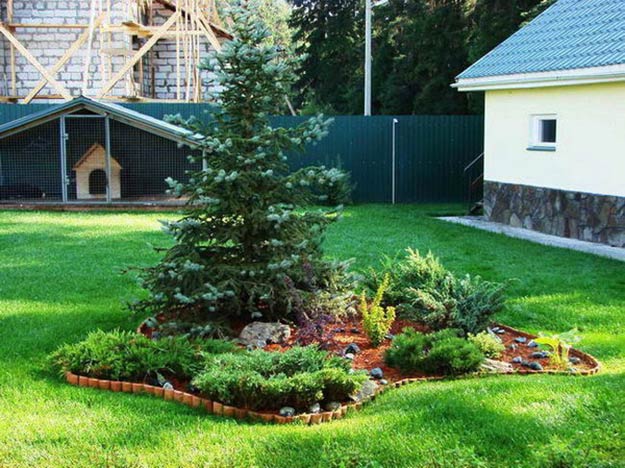
Where to begin
Of course, it’s better to start not with a trip to the store for seedlings, but with the simplest thing - a fascinating walk around the site and choosing the perfect place for your long-lasting flower bed. Only after you carefully plan where it will be located and how much space it will occupy, you can return home. Now take a sheet of paper and a pencil and start transferring all your fantasies to paper, having previously decided on the varieties that are ideal for your creation.
To avoid mistakes, consider all the features regarding the future composition:
- choosing the ideal location (sunny, sheltered from the wind);
- soil composition;
- occurrence of deep waters;
- plot size;
- architecture of the house and yard buildings.
Want to little advice? Before you start drawing up a flower bed plan, carefully review the photos of such compositions. Do not immediately choose the most difficult methods, because you can hardly cope with them without experience. But a simple scheme is a great option to borrow something useful for yourself and create your own, original and unique.
The best coniferous plants for flower beds
Before you buy, be sure to ask how high adult plants grow. I think you will agree with me that huge pines or spruces will look rather ridiculous around a house with a small area. It is also important to remember that for a flower bed it is better to choose plants that grow and develop evenly. This will prevent some varieties from drowning out and shading others. This information can be obtained from sales consultants or independently found on the Internet.
Be sure to pay attention to the combination of different varieties. Although conifers are most often green or with a bluish-gray tint, but exotic bright varieties can slightly spoil the composition, attracting too much attention to themselves.
I advise you to try to create a composition from such conifers with your own hands:
- juniper;
- fir;
- dwarf pine;
- blue or ordinary spruce (undersized varieties).
A little trick - among the conifers, shrubs and dwarf trees of other species will look interesting and original, but do not overdo it, because after all, you create a flower bed not from decorative leafy or flowering plants!
Detailed schemes with names will help you, thanks to which you can easily cope with the work. I only warn you that before sending to the site, be sure to calculate everything several times and think over the smallest details.
Proper planting
Getting started, be sure to arm yourself with a tape measure and pre-prepared pegs and carefully measure the area on which you will plant conifers. Mix the top layer of soil with peat and a little sand.
Decorate the flower bed with stones, pebbles and cobblestones. Little secret- do not make straight, strict lines, a composition with broken or slightly wavy edges looks much more natural and natural. Be sure to keep the drawn plan on hand, because you don’t want to spoil the most important process, right?
Dig holes according to the root system of each seedling. Be sure to put drainage and. Long-term top dressing can be combined with a mixture of peat, sand and soil, its effect will not change. It remains quite a bit - to plant the conifers, carefully spreading the roots, carefully tamp and be sure to put a layer of mulch.
As you can see, everything is quite simple. All you need to create a decorative evergreen oasis near your home is a little imagination, skillful hands and carefully selected plants. If you liked our topic of discussion today, be sure to share it with your friends on social networks. Also, the last tip for today is to subscribe to updates, because the pages of my blog are always full of interesting and useful information. I say goodbye for a very short time, all the best to you!
A good gardener, like an artist, does not just plant his favorite plants, but creates real living pictures, mixing colors and textures. Therefore, the flower beds can look like a real work of art, decorating the design of the site, garden and home.
The selection of plants for a flower bed must be approached very responsibly. These crops must be suitable in height, color, flowering time, consistent with the general idea, which is quite difficult to do. But a well-thought-out flower planting will delight with its beauty, blooming with a riot of colors at the same time or alternately replacing flowering plants one after another.
When choosing plants, you need to consider:
plant color
It has been proven more than once that color has a huge impact on a person’s mood, so flower beds of different colors will bring their own atmosphere to the garden:
- red and orange tones of flowers excite nervous system and are not suitable for prolonged viewing, as they can cause irritability;
- blue and blue color produce a calming effect;
- the combination of yellow and orange energizes and illuminates the site even on gloomy rainy days.
In addition to these stable combinations, various combinations of shades are used, even contrasting and unusual ones, using plants of white flowers to smooth out the impression.
Also, when choosing a color, you need to take into account natural lighting, if the flower bed is in the shade, then it is recommended to use bright rich colors, since delicate blue, blue and purple look faded and not spectacular when shading.
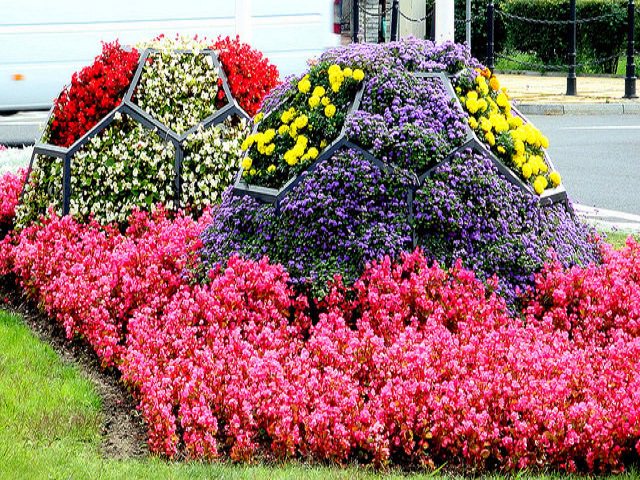
To roughly imagine appearance future flower beds, you can take up colored pencils and sketch out the desired pattern of the drawing, checking the combination of the desired colors and shades. It is also recommended to use bright, warm and even aggressive red and orange to highlight the main elements of planting, and use gentle passive green, purple and blue to decorate the background and make the flower bed austere. It is recommended not to get carried away with a large number of colors and to withstand a range of 3-5 different colors in one flower garden in order to avoid clumsiness and oversaturation.
All plants have their own lighting preferences. Most of them prefer to grow in sunny areas or in partial shade, some need constant sunlight, while shade-loving ones prefer permanent shade. Depending on the location of the flower bed and its lighting, the crops planted on it are also selected.
The bulk of flower plants prefer sunny places, but shade-loving and shade-tolerant ones are better suited for planting in partial shade: pansies, marigolds, mallows, cornflowers, petunias, forget-me-nots, daisies. There are also shade-loving perennial crops, among them the most popular are hosts, lilies of the valley, astilbes, delphiniums.
Height
High relief flower beds look great. To create them, tall crops, mostly perennials, are planted in the center or at the far edge of the wall planting, and closer to the edge, the height of the plants is reduced so that each individual flower is clearly visible, as in the photo. A couple of tall crops are chosen as soloists, the selection of the rest of the inhabitants of the flower garden depends on their height: if we take a plant of medium height as a basis, then for the outskirts it will be necessary to select miniature flowers, and in the case of planting a well-developed tall bush or plant, all other plantings can be higher.
Density
Many gardeners make the mistake of planting perennial crops too close together in a flower garden. In this case, the flower bed will look good for the first couple of years, but soon the plants, growing up, will interfere with their neighbors and suffer from crowding. In addition, some flowers, such as geranium or catnip, look better in a loose fit, as in the photo, which must be considered when planting a flower garden.
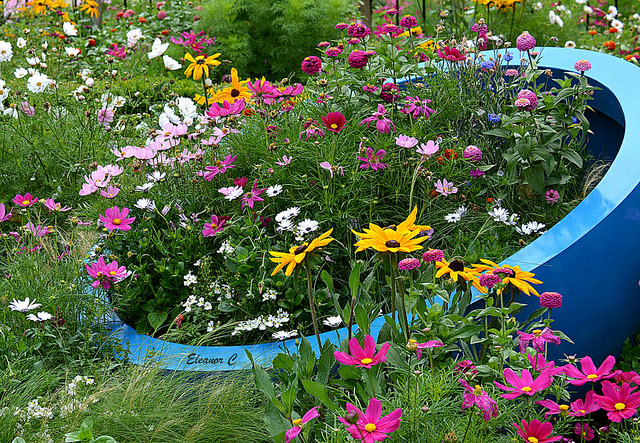
Illumination of flower beds
flowering time
In order for the flower garden to please with its beauty throughout the season, you need to make sure that the plants planted in it have different flowering times, replacing each other. Also, bright decorative leaves of some non-flowering crops will help to increase the decorativeness of the flower bed. Bright flowers with a short flowering period are best planted singly or in groups surrounded by plants that bloom later.
Depending on the type of flower beds are used different kinds plants:
- Mixborders are flower beds of irregular geometric shapes, which are created using both annual and perennial crops, and in mixborders large sizes even trees and shrubs. The selection of plants is carried out taking into account their continuous flowering; cultures that do not bloom, but have beautiful decorative leaves, are also widely used. An example of mixborders can be seen in the photo.
- Rockery - a flower bed using large stones as decorative elements, its example is shown in the photo. Often these are decorated with artificial fountains and ponds.
Surrounded by stones, thorns of the eryngium look great, as well as delicate bluebells, phlox, thyme, lamb, irises, primroses and violets. The latest flower crops will bring bright colors and variety to the flower garden. Tulip and daffodil buds will bloom no less effectively, and wide and juicy leaves of hostas, ferns and geyher will decorate the flower bed after the flowering of the main crops and add a touch of elegance.
- Regular flower bed
This is the name of the flower beds of regular geometric shapes, as in the photo. For them, undersized one- or two-year-old or bulbous flowers are used. Such flower beds require constant care, since the correctness of forms and lines does not accept deviations from the original pattern.
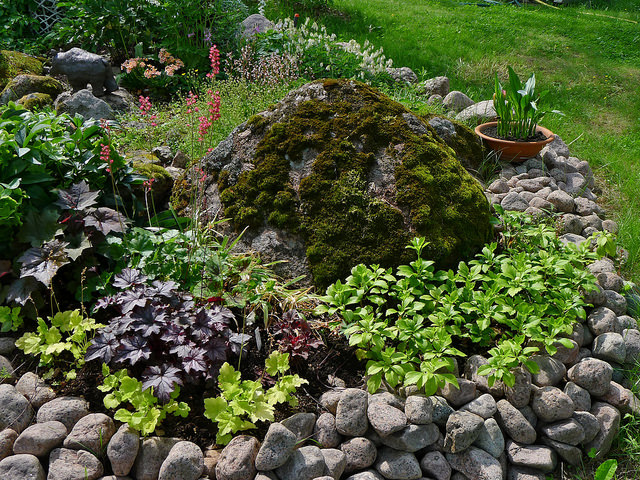
As a rule, large flat areas of parks and recreation areas in cities are decorated with regular flower beds, and they are rarely used to decorate a private garden because of the difficulty in maintenance. Indeed, in order to preserve beauty after flowering, the plants need to be dug up and replaced with others with later flowering, which is unacceptable for most gardeners.
For small gardens, decorating unattractive corners of the site, as well as separating various zones, vertical flower beds are widely used. The basis for them can be gazebos, special supports such as trellises, pergolas or arches, or suspended on a veranda.
To create vertical flower beds, you will have to make a lot of effort, but their beauty is unusual and justifies all efforts. In addition, such landings occupy small areas and are perfect for small courtyards. Most often, annual crops with long flexible shoots and abundant flowering are used to create vertical flower beds, for example, petunias, nasturtiums or begonias. But when placing such flower beds, you need to remember that many ampelous crops, for example, petunias, are shade-loving and do not tolerate constant scorching sunlight.
A beautiful greenish background gives silver dichondra, which is valued not for small dull flowers, but for beautiful green-silvery foliage. Also, some decorative ground cover crops, for example, nolans, can be used in vertical flower beds.
- Ribbons and borders
They are used for paths and walls of buildings; for these types of flower beds, flowering perennials (primroses, phloxes, saxifrages, cymes) are used.
- Group landings
These types of flower beds are made from one type of plant, for example, tulips or organically combined 2-3 types of flowers. They should look as if they were created by nature itself without human intervention. Group plantings are used to decorate the walls of the house, fountains and sculptures.
The ideal solution for a small yard is a small regular-shaped flower garden that uses one type of plant.

- Irregular flower beds
The most common type of flower garden in the garden. To create it use different types crops, selecting them so that flowering is continuous. It is also recommended to plant tall plants closer to the center or far edge, and as you approach the near border of the flower bed, plant smaller and smaller forms of flowers. The beauty of these flower beds is the complete absence of strict rules for arrangement.
Features of flower beds from different types of plants
Consider the main features of flower beds from different types of plants:
Coniferous flower beds
The evergreen branches of coniferous crops attract with their beauty and bright color, which decorates the garden so spectacularly even in snowy winters. AT landscape design both shrubs and tree species are widely used, their selection depends on the type of flower bed and its design.
For small, neat flower beds, low-growing, compact, slow-growing shrubby forms of conifers are suitable. Flowerbeds of coniferous plants look great, in which low bushes of juniper or similar shrubs are adjacent to ground cover flowers. An example of such a flower bed can be seen in the photo.
Coniferous plants in mixborders look no less impressive, for this they use dwarf varieties of fir, pine, spruce, as well as undersized juniper or thuja. The planting of these crops is carried out so that the tallest ones are placed in the background, leaving the front areas for the small creepers.
Representatives of coniferous varieties also look organic in an alpine hill, often spruce, larch, juniper, fir, microbiota and other plants inherent in alpine slopes are used in this type of flower beds.
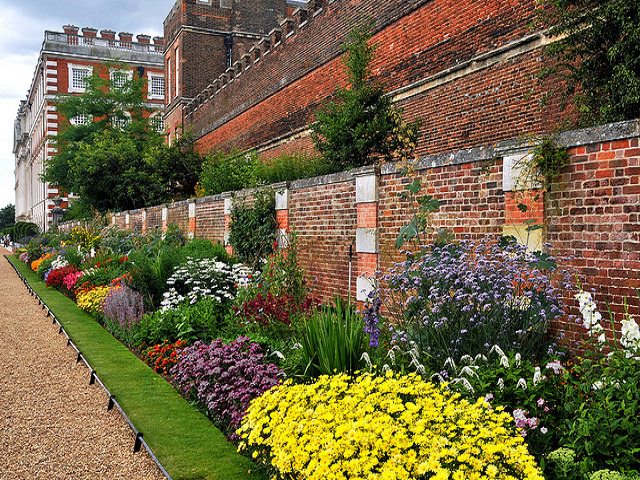
Other shrubs, such as rhododendron, heather, boxwood, barberry, go well with coniferous plants. The use of herbaceous crops, for example, cereals or ferns, also perfectly complements the composition. No less impressive is the combination of low-growing coniferous crops with ground cover sedums, survivors, thyme or phlox.
When planting coniferous perennials in a flower bed, you need to remember about their further growth in order to avoid losing the original shape of the flower garden and an imbalance between the height and volume of grown bushes and trees in a couple of years.
The great advantage of these is easier care, because, unlike annuals, they do not need to be sown, replanted and nursed annually from small weak sprouts.
In addition, their diversity is simply amazing. Depending on the height, perennial plants are divided into:
- Ground covers, up to 20 centimeters high, are perfect as a border for a small, neat flower bed. These include the small periwinkle, saxifrage, creeping speedwell.
- Undersized, reaching a height of up to 30 cm. This group includes the Carpathian bell, irises, and perennial asters.
- Medium-sized have a height of up to 70 centimeters and are suitable as soloists, these include echinacea, rudbeckia and shade-loving aquilegia.
- Tall, having a height of over 80 centimeters, are used as soloists and solitary plants. These include large-headed cornflower, delphinium and Japanese keriya.




